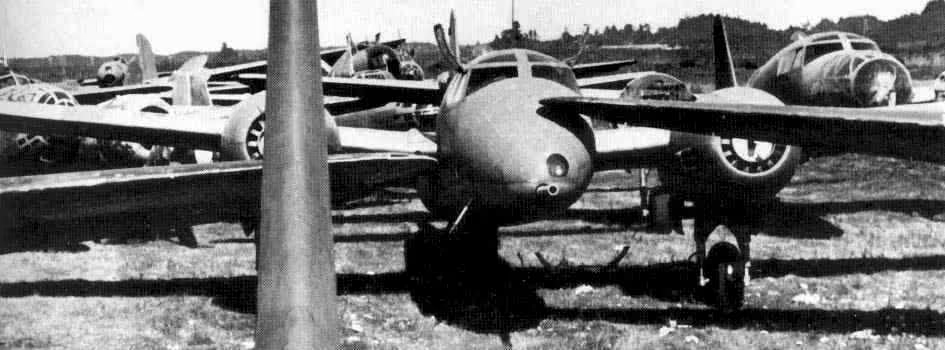Warplanes of Japan: Mitsubishi Ki-109
Mitsubishi Ki-109

(USAAF Photo)
Mitsubishi Ki-109 fighter prototype in the USA. This twin engine bomber is possibly one of five aircraft listed as a Ki-67 shipped to the USA, designated USAAF FE-2200 scrapped at Middletown, FE-2201 scrapped at Newark, FE-2202 scrapped at Middletown, FE-2203 scrapped at Newark, and FE-2204 also scrapped scrapped at Newark.
The designation Mitsubishi Ki-109 was used for two different attempts to produce an interceptor based on Ki-67 heavy bomber that would be capable of shooting down the new B-29 bombers. The first design, suggested in November 1943, was for a 'Killer-Hunter' team of two aircraft. The Ki-109a would have been the killer, armed with two obliquely mounted 37mm Ho-203 cannon, while the Ki-109b would have been the hunter, equipped with radar and a nose mounted 40cm searchlight. The second design was proposed by Major Hideo Sakamoto, the officer in charge of the Ki-67 evaluation programme. He suggested mounting an Army 75mm Type 88 anti-aircraft cannon in the nose of the Ki-67. This would reduce the speed and manoeuvrability of the aircraft, but allow it to operate outside the range of the B-29's guns, and was produced in the belief that the American bombers would be forced to operate without fighter cover. This second design was approved on 20 February 1944.
The prototype Ki-109 retained the defensive guns of the Ki-67, but with a new nose and stronger fuselage. From the third aircraft the dorsal turret and lateral machine gun positions were removed. The prototype was completed in August 1944, two months after the first B-29s appeared over Japan, and production began later in the same year. Twenty two aircraft were produced using the Ha-104 engine as the Ki-109-I. They were to be followed by the Ki-109-II, using the 1,900hp turbo-supercharged Ha-104ru engine, but this version never entered production. The 107th Heavy Fighter Regiment was formed in November 1944, and received its aircraft in 1945. The Ki-109 failed to live up to expectations. The production Ki-109-I lacked the speed and rate of climb to catch the high flying B-29s on their early daylight raids, and despite a number of attempted interceptions never actually made contact with a B-29 formation. Once the Americans switched to low level night-time raids the Ki-109, which lacked radar, became completely useless, and the 107th Heavy Fighter Regiment was disbanded on 30 July 1945. (Forgotten Secret Weapon Wiki)
Ki-109: Night fighter prototypes. Ki-67-Imodified for night fighting for operating in pairs, the Ki-109a with aradar/reflector (similar to the British Douglas Havoc II "Turbinlite"concept, only using radio beams rather than a powerful searchlight) for radartransmission and detection and the Ki-109b, armed with twin 37 mm Ho-203 cannonin an upward-firing Schrage Musik-style fixed dorsal mount (as the singleHo-203 autocannon in the Mitsubishi Ki-46-III KAI was) to destroy theobjective. Only a project.
Ki-109: Day Fighter prototypes. Ki-67-I modified for daylight fighting. Onefixed 75 mm Type 88 Heavy Cannon in the nose and one mobile 12.7 mm (0.5 in)Ho-103 Type 1 machine gun in the tail. Equipped with Mitsubishi Ha-104 enginesof 1,417 kW (1,900 hp) each or turbocharged Ha-104 Ru with 1,417 kW (1,900 hp)each. 2 produced.
Ki-109 Army Heavy Fighter Interceptor: First non-prototype model of series.Lacking gun positions in upper and side positions and without bomb-baycompartments[citation needed]. Fixed 75 mm Type 88 Heavy Cannon in the noseretained from Day Fighter prototype. Had a revised version of tail gun. 22constructed by Mitsubishi.
Ki-112: Bomber escort fighter made with a wooden construction. Armed with 8 x12.7mm and 1 x 20mm. Only a project.
Ki-167 "Sakura-dan": "Special Attack" (kamikaze) versionequipped with one shaped charge thermite bomb of 2,900 kg (6,400 lb) in thefuselage behind the crew cabin. The shape of the bomb conducted the blastforward, projecting a jet capable of reaching nearly a mile with a maximumblast radius of 300 m (980 ft). The bomb was designed to breach emplacements aswell as to destroy massed formations of armor. 9 produced.
Q2M1 Taiyo: Navy variant of Ki-67-I, for anti-submarine warfare. Equipped withradar (Type3 Model 1 MAD (KMX), Type 3 Ku-6 Model 4 Radar, and ESM Antennaequipment). Had two Mitsubishi Kasei 25 Otsu engines of 1,380 kW (1,850 hp)each with six-blade propellers. Carried torpedoes or depth charges. Projectonly. (Wikipedia)


(IJAAF Photo)
Mitsubishi Ki-109 fighter prototype. This aircraft is a Ki-67-I modified for daylight fighting. It was armed with one fixed 75-mm Type 88 Heavy Cannon in the nose and one mobile 12.7-mm (0.5 in) Ho-103 Type 1 machine gun in the tail. It was equipped with Mitsubishi Ha-104 engines of 1,417 kW (1,900 hp) each or turbochargers Ha-104 Ru with 1,417 kW (1,900 hp) each. Two were produced.




(USAAF Photos)
Mitsubishi Ki-109 fighter prototype in the USA. This twin engine bomber is possibly one of five aircraft listed as a Ki-67 shipped to the USA, designated USAAF FE-2200 scrapped at Middletown, FE-2201 scrapped at Newark, FE-2202 scrapped at Middletown, FE-2203 scrapped at Newark, and FE-2204 also scrapped scrapped at Newark.





